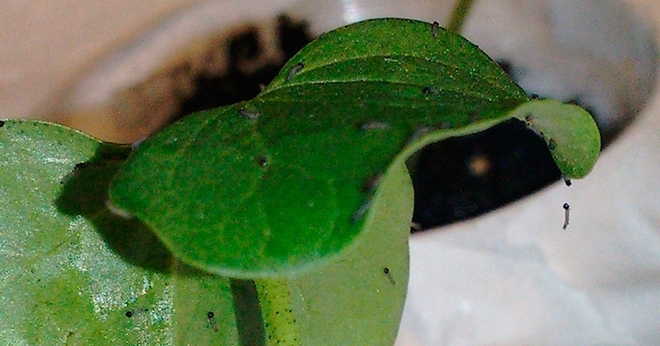

Technology developed by researchers at two Brazilian universities could help manage crop-attacking insects more effectively (photo: Wesley Augusto Conde Godoy / ESALQ-USP)
Technology developed by researchers at two Brazilian universities could help manage crop-attacking insects more effectively.
Technology developed by researchers at two Brazilian universities could help manage crop-attacking insects more effectively.

Technology developed by researchers at two Brazilian universities could help manage crop-attacking insects more effectively (photo: Wesley Augusto Conde Godoy / ESALQ-USP)
By Elton Alisson | Agência FAPESP – The Fall armyworm (Spodoptera frugiperda), a lepidopteran pest that feeds on leaves and stems of as many as 100 plant species, is able to hop between different crops and cause serious damage due to its resistance to both insecticides and transgenic plants that are genetically engineered to express proteins with insecticidal action obtained from the bacterium Bacillus thuringiensis Berliner (Bt).
To better understand how this and other insects disperse in agricultural areas, so that farmers can manage them more effectively, researchers at the University of São Paulo’s Luiz de Queiroz College of Agriculture (ESALQ-USP), in collaboration with colleagues at São Paulo State University (UNESP) in Botucatu, Brazil, have developed mathematical models to describe the movements of agricultural pests.
Some of the most recent results of the study, which is supported by FAPESP, have been published in Scientific Reports.
“The idea is to use computer models to design strategies capable of reducing the damage done to crops by pest populations and containing their expansion on plantations,” said Wesley Augusto Conde Godoy, a professor at ESALQ-USP and principal investigator for the project, in an interview given to Agência FAPESP.
First, the researchers modeled the movements of the cucurbit beetle, Diabrotica speciosa, which attacks several crops, such as soybeans, corn and cotton.
Using computer modeling, they found that spatial configurations in diversified intercropping systems (growing two or more crops in proximity) could favor or inhibit pest dispersal. “We observed that the presence of corn strips distributed across farmed fields could reduce spatial dispersal of the insects,” Godoy said.
Motivated by the results obtained with D. speciosa, they investigated possible applications of computer modeling to describe the spatial dynamics of other agricultural pests, such as S. frugiperda, which has developed resistance to Bt corn, cotton and soybeans.
Technicians have advised farmers to delay the development of resistance to Bt crops in S. frugiperda and other pests by creating refuges, strips within Bt crop fields of the same crop without a Bt trait.
Refuges are intended to ensure the maintenance of individuals susceptible to Bt technology within the pest population. They mate with resistant individuals, and this prevents the population as a whole from developing resistance to Bt toxins, Godoy explained. “It’s been demonstrated that the larger the refuge area is, the lower the frequency of Bt-resistant individuals,” he said.
Using a cellular automata-based computer model that predicts the movements of insects, the researchers measured the effectiveness of three different refuge configurations: mixed seeds, random blocks, and strips.
“We succeeded in identifying the best refuge configuration and size to delay the development of Bt crop resistance in S. frugiperda,” Godoy said.
Comparing movement patterns
The researchers combined the computer model with data on the insect’s movements obtained in the laboratory to analyze and compare its behavior on leaves of Bt and non-Bt cotton. The results of the study showed that the insect moved around more on Bt cotton leaves than non-Bt cotton leaves.
“We don’t yet know what mechanisms may trigger this behavior,” Godoy said. “However, the findings so far have important practical implications because they may correlate with faster development of Bt resistance.”
Less movement on non-Bt leaves could be associated with adaptation cost. This is frequently the case for resistant populations of this insect in the absence of selection pressure, he explained.
“We plan to continue investigating this problem, as continuation of the research could produce significant contributions to pest management programs by improving crop configuration to delay the development of resistance to GM crops among these and other insects,” Godoy said.
The Scientific Reports article “Larval dispersal of Spodoptera frugiperda strains on Bt cotton: a model for understanding resistance evolution and consequences for its management” (doi: 10.1038/s41598-017-16094-x) by José B. Malaquias, Wesley A. C. Godoy, Adriano G. Garcia, Francisco de S. Ramalho and Celso Omoto can be read at nature.com/articles/s41598-017-16094-x.
Republish
The Agency FAPESP licenses news via Creative Commons (CC-BY-NC-ND) so that they can be republished free of charge and in a simple way by other digital or printed vehicles. Agência FAPESP must be credited as the source of the content being republished and the name of the reporter (if any) must be attributed. Using the HMTL button below allows compliance with these rules, detailed in Digital Republishing Policy FAPESP.





